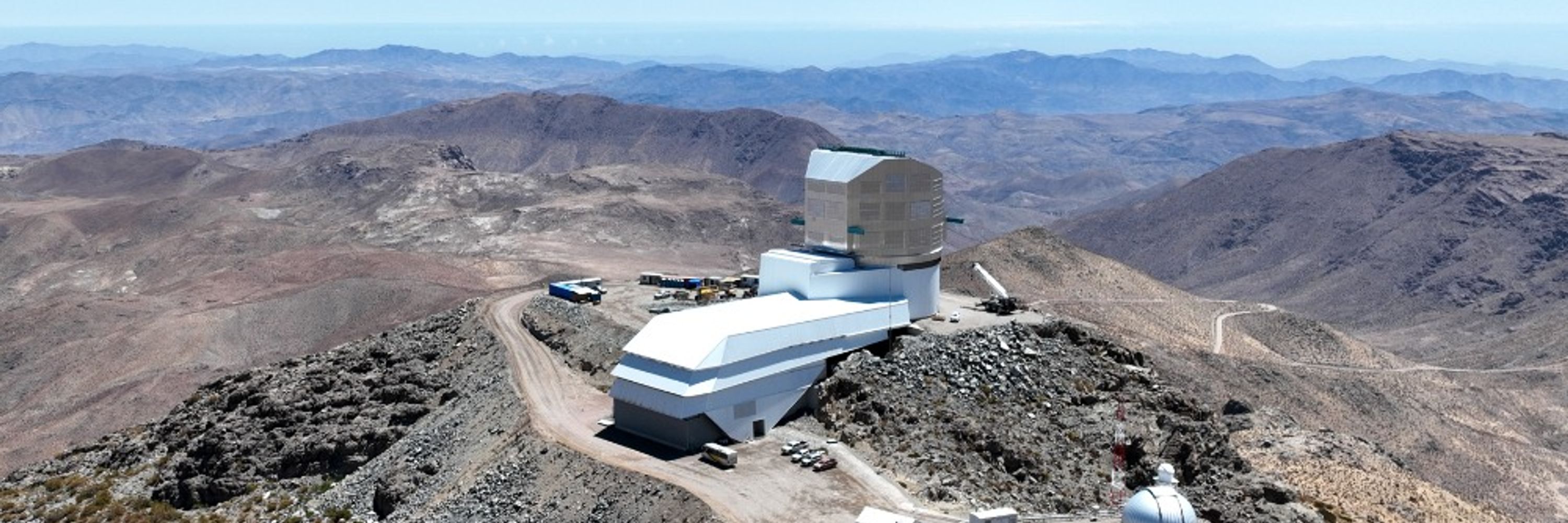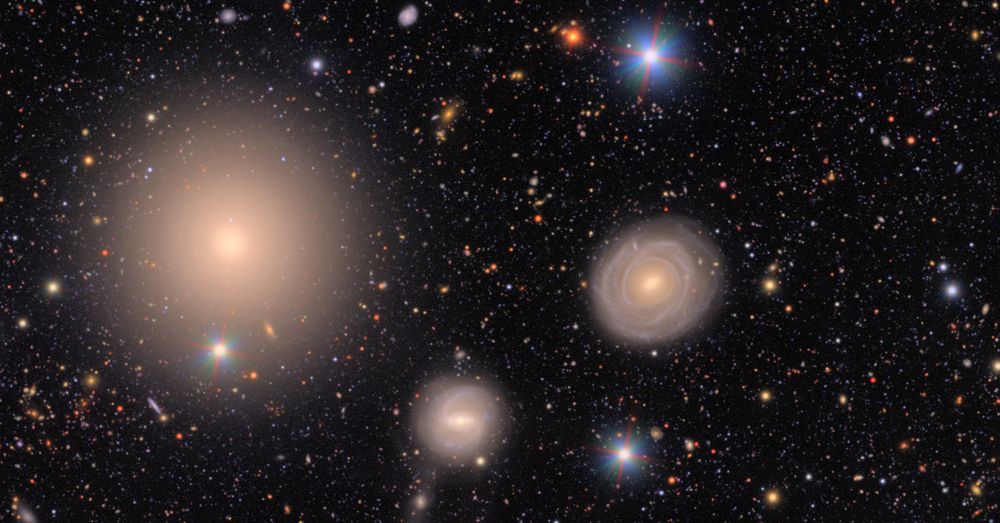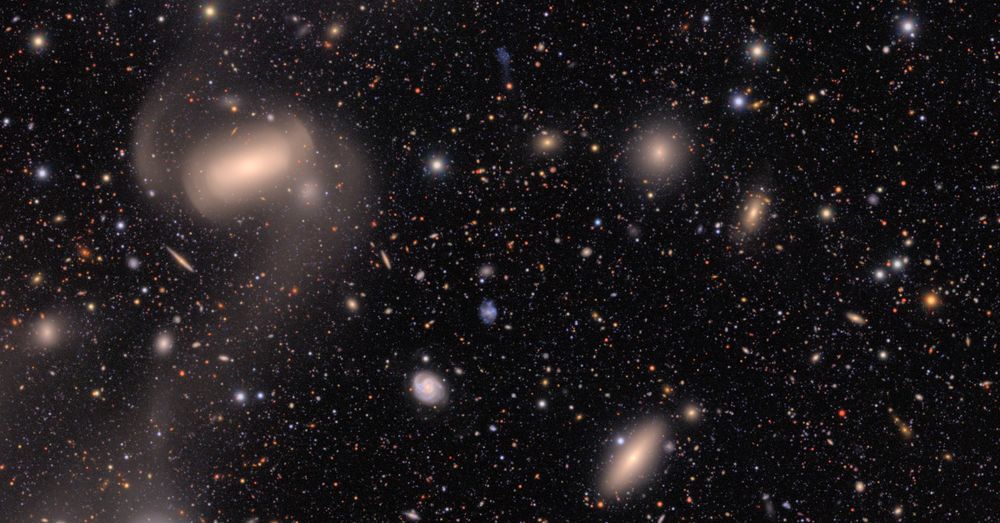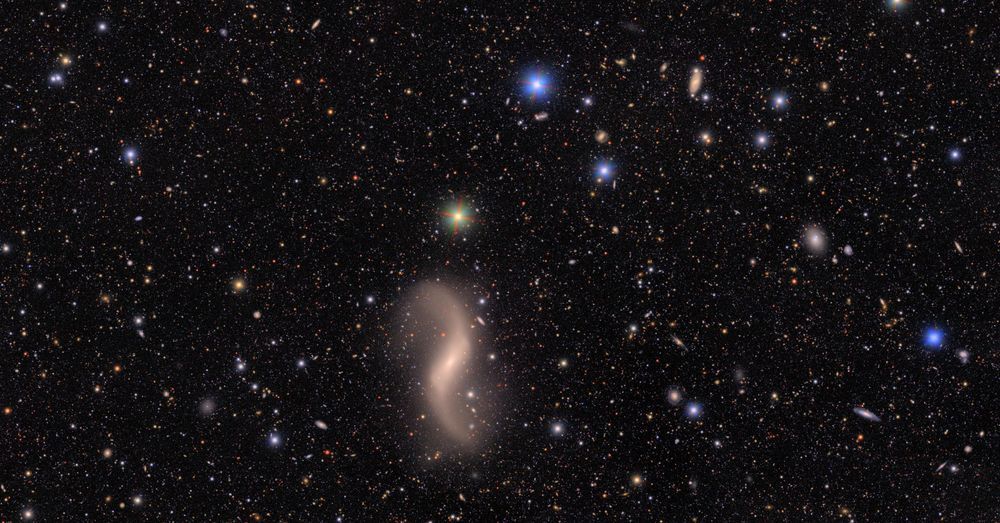
Para español siga a Instagram: http://instagram.com/rubin_observatory




Pan, zoom, and hunt for gems in this treasure chest using Skyviewer - and be sure to share your favorites with us! 🔭🧪
➡️ skyviewer.app/explorer
Mechanical Engineer Margaux Lopez started at SLAC in California and moved to Chile in 2019 to help build the NSF–DOE Rubin Observatory. 🔭🧪
Learn about the challenges and curiosity that drive her work!
🎥 Meet Margaux https://youtu.be/Lk8bgNQtcEo
Mechanical Engineer Margaux Lopez started at SLAC in California and moved to Chile in 2019 to help build the NSF–DOE Rubin Observatory. 🔭🧪
Learn about the challenges and curiosity that drive her work!
🎥 Meet Margaux https://youtu.be/Lk8bgNQtcEo
Dark matter interacts via gravity, so while we can’t see it directly, we know it’s there.
NSF–DOE Rubin Observatory's 10-year survey will measure distortions in billions of galaxies, revealing where dark matter is hiding.🔭🧪

Dark matter interacts via gravity, so while we can’t see it directly, we know it’s there.
NSF–DOE Rubin Observatory's 10-year survey will measure distortions in billions of galaxies, revealing where dark matter is hiding.🔭🧪
Sandrine Thomas, Deputy Director for NSF–DOE Rubin Observatory Construction, reflects on her path — moving from France to the US, traveling to Chile, and sharing her work with her family.
🎥 Meet Sandrine https://youtu.be/_r-e0kzYjf4
Sandrine Thomas, Deputy Director for NSF–DOE Rubin Observatory Construction, reflects on her path — moving from France to the US, traveling to Chile, and sharing her work with her family.
🎥 Meet Sandrine https://youtu.be/_r-e0kzYjf4
In this image from the #RubinFirstLook Cosmic Treasure Chest, a distant galaxy peeks from behind a large foreground galaxy.
This "layered" view helps scientists understand the 3D structure of the Universe 🌌🔭🧪

In this image from the #RubinFirstLook Cosmic Treasure Chest, a distant galaxy peeks from behind a large foreground galaxy.
This "layered" view helps scientists understand the 3D structure of the Universe 🌌🔭🧪
This composite was built from ~6,000 photos taken on a night in mid-July, each contributing just one column of pixels.
Look closely and you’ll spot stars starting to twinkle in the upper left as the night begins ✨🔭🧪

This composite was built from ~6,000 photos taken on a night in mid-July, each contributing just one column of pixels.
Look closely and you’ll spot stars starting to twinkle in the upper left as the night begins ✨🔭🧪
Tidal tails are cosmic “receipts” of galactic drama, showing who collided with whom. Rubin's camera is sharp enough to catch wind of even the faintest intergalactic tea.
No need to worry about "pics or it didn't happen" with Rubin keeping a close eye 😎 🔭🧪

Tidal tails are cosmic “receipts” of galactic drama, showing who collided with whom. Rubin's camera is sharp enough to catch wind of even the faintest intergalactic tea.
No need to worry about "pics or it didn't happen" with Rubin keeping a close eye 😎 🔭🧪
Freddy Muñoz, who leads NSF–DOE Vera C. Rubin Observatory's mechanical team on the summit, discusses how the speed of Rubin's Simonyi Survey Telescope will let us capture more objects in the Universe than ever before. 🔭🧪
🎥 Meet Freddy https://youtu.be/Vg7ZgU4y-dg
Freddy Muñoz, who leads NSF–DOE Vera C. Rubin Observatory's mechanical team on the summit, discusses how the speed of Rubin's Simonyi Survey Telescope will let us capture more objects in the Universe than ever before. 🔭🧪
🎥 Meet Freddy https://youtu.be/Vg7ZgU4y-dg
Think of Rubin Observatory as a friend constantly scrolling through the Universe’s social media feed. Every minute, they refresh and see what’s new — an asteroid has moved, a star has changed in brightness...or maybe even exploded in a supernova. 🔭🧪
Think of Rubin Observatory as a friend constantly scrolling through the Universe’s social media feed. Every minute, they refresh and see what’s new — an asteroid has moved, a star has changed in brightness...or maybe even exploded in a supernova. 🔭🧪
NSF–DOE Rubin Observatory is like a cosmic watchtower, capturing the entire visible sky every few nights.
Before, scientists would spend their careers looking for supernovae. But Rubin will accomplish in minutes or hours what used to take a lifetime! 🔭🧪

NSF–DOE Rubin Observatory is like a cosmic watchtower, capturing the entire visible sky every few nights.
Before, scientists would spend their careers looking for supernovae. But Rubin will accomplish in minutes or hours what used to take a lifetime! 🔭🧪
Meet Tiago Ribeiro, Scheduler Scientist and Software Architect at NSF–DOE Rubin Observatory.
In this video, he shares his path from professor in Brazil to shaping large-scale projects like Rubin.
🎥 https://youtu.be/EnxGm5MtXjE
Meet Tiago Ribeiro, Scheduler Scientist and Software Architect at NSF–DOE Rubin Observatory.
In this video, he shares his path from professor in Brazil to shaping large-scale projects like Rubin.
🎥 https://youtu.be/EnxGm5MtXjE
Hernán Bustos Binvignat, recently-retired Deputy Director at AURA in Chile — the organization that manages NSF–DOE Rubin Observatory — reflects on a career dedicated to world-class astronomy. 🔭🧪
🎥 Meet Hernán https://youtu.be/AoXYTPHsQwE
Hernán Bustos Binvignat, recently-retired Deputy Director at AURA in Chile — the organization that manages NSF–DOE Rubin Observatory — reflects on a career dedicated to world-class astronomy. 🔭🧪
🎥 Meet Hernán https://youtu.be/AoXYTPHsQwE
NSF–DOE Rubin Observatory basks in that sunset ✨glow✨ at its site on Cerro Pachón. And with over 300 clear nights on average per year here, that's a lot of sunset basking we get to do! 🔭🧪




NSF–DOE Rubin Observatory basks in that sunset ✨glow✨ at its site on Cerro Pachón. And with over 300 clear nights on average per year here, that's a lot of sunset basking we get to do! 🔭🧪
How does Rubin take sharp images of the cosmos from the ground? Computer-controlled actuators adjust its mirrors and camera against wind or gravity in real time, keeping everything perfectly aligned. 💨🪞✨

How does Rubin take sharp images of the cosmos from the ground? Computer-controlled actuators adjust its mirrors and camera against wind or gravity in real time, keeping everything perfectly aligned. 💨🪞✨
The Moon is dazzlingly bright — so bright that NSF-DOE Rubin Observatory will never point at it. But there are many Solar System objects that are incredibly faint, and that’s where Rubin shines.🔭🧪




The Moon is dazzlingly bright — so bright that NSF-DOE Rubin Observatory will never point at it. But there are many Solar System objects that are incredibly faint, and that’s where Rubin shines.🔭🧪
No, Gretchen, it's not, but we're trying to figure out what it is!
At 85% percent of the Universe's mass and energy, it's sort of like Gretchen's hair: big and full of secrets. 🔭🧪
📷: W. O'Mullane

No, Gretchen, it's not, but we're trying to figure out what it is!
At 85% percent of the Universe's mass and energy, it's sort of like Gretchen's hair: big and full of secrets. 🔭🧪
📷: W. O'Mullane
Franco Colleoni, Electronic Engineer, shares the rewarding aspects of his work on Rubin's vital systems. 🔭🧪
🎥 Meet Franco: https://youtu.be/NMPBIBF2vdw
Franco Colleoni, Electronic Engineer, shares the rewarding aspects of his work on Rubin's vital systems. 🔭🧪
🎥 Meet Franco: https://youtu.be/NMPBIBF2vdw
At NSF–DOE Rubin Observatory, the secret to achieving a glowing-from-within look is our calibration screen.🔭 🧪
It's glamorous, we know 💅
🧵

At NSF–DOE Rubin Observatory, the secret to achieving a glowing-from-within look is our calibration screen.🔭 🧪
It's glamorous, we know 💅
🧵
(Ok, it's both.)
These local celebrities are a favorite sighting among observatory scientists — they even bask in the sunset glow just like observers do before the night! 🔭🧪




(Ok, it's both.)
These local celebrities are a favorite sighting among observatory scientists — they even bask in the sunset glow just like observers do before the night! 🔭🧪
Meet Sandra Romero, NSF–DOE Rubin Observatory's Safety Lead. 🔭
Her job? Keeping Rubin safe for everyone who works here, from construction activities to science operations✨
🎥 Meet Sandra: https://youtu.be/3gJMxs2nFnQ

Meet Sandra Romero, NSF–DOE Rubin Observatory's Safety Lead. 🔭
Her job? Keeping Rubin safe for everyone who works here, from construction activities to science operations✨
🎥 Meet Sandra: https://youtu.be/3gJMxs2nFnQ
Join us for the #RubinConstructionArchives series, every Tuesday and Thursday on Youtube through November! 🔭 🧪
youtube.com/RubinObservatory
Join us for the #RubinConstructionArchives series, every Tuesday and Thursday on Youtube through November! 🔭 🧪
youtube.com/RubinObservatory
Today is the September #equinox, the first day of spring in the Southern hemisphere. That means we’re swapping the cool, crisp tones of snow and winter for the fresh, warm hues of spring just around the corner.💐
🔭 🧪




Today is the September #equinox, the first day of spring in the Southern hemisphere. That means we’re swapping the cool, crisp tones of snow and winter for the fresh, warm hues of spring just around the corner.💐
🔭 🧪
...we're not mad about it though.
This spectacular nightscape of NSF–DOE Rubin Observatory in Chile features the striking band of the Milky Way and its companions.🔭 🧪

...we're not mad about it though.
This spectacular nightscape of NSF–DOE Rubin Observatory in Chile features the striking band of the Milky Way and its companions.🔭 🧪
NSF–DOE Rubin Observatory sits stop Cerro Pachón in Chile, but we have remote observing locations in Chile and the US!
Read about how the control room at SLAC will help enable Rubin to #CaptureTheCosmos: rubinobservatory.org/news/slac-co...



NSF–DOE Rubin Observatory sits stop Cerro Pachón in Chile, but we have remote observing locations in Chile and the US!
Read about how the control room at SLAC will help enable Rubin to #CaptureTheCosmos: rubinobservatory.org/news/slac-co...
Today is Chile's Independence Day! We wish all of our colleagues and neighbors a joyful and safe #Dieciocho 💃 🔭
Today is Chile's Independence Day! We wish all of our colleagues and neighbors a joyful and safe #Dieciocho 💃 🔭
NSF–DOE Rubin Observatory's telescope mount is balanced and rigid, reducing vibrations and allowing the LSST Camera to be ready for its next image in only 5 seconds. 🔭🧪

NSF–DOE Rubin Observatory's telescope mount is balanced and rigid, reducing vibrations and allowing the LSST Camera to be ready for its next image in only 5 seconds. 🔭🧪

